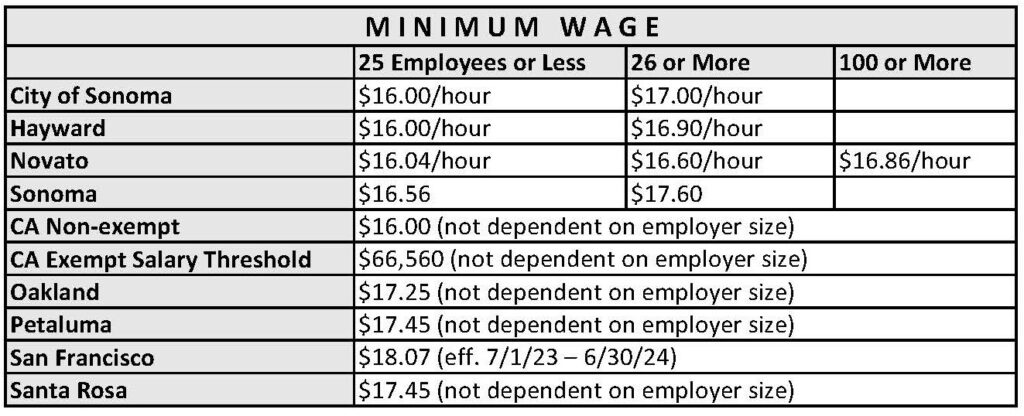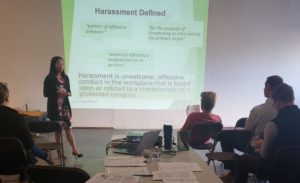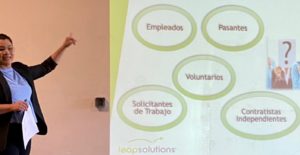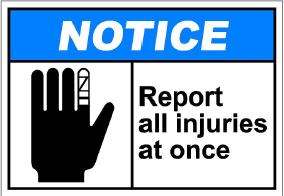Leapsolutions | December 19, 2023
By, Tracy Emmerich & Tracy Long
The California legislature saw fit to pass several employment laws that will go into effect on January 1, 2024 and beyond. As always, Leap Solutions is here to help you face them proactively and confidently. Our HR professionals have the knowledge, expertise, and resources to inform and guide you through ever-changing legislation and empower your company to thrive in 2024 and beyond.
In this issue of our newsletter:
- 2024 Minimum Wage
- Updates on Current and New Legislative Bills
- Meal and Rest Break Premium Pay
- Ongoing Mandatory Harassment Prevention Training
- Employee Handbook Review/Updates
- Injury and Illness Prevention Program and COVID Prevention Plan
- California Labor Law Posters
2024 MINIMUM WAGE

January 1, 2024 brings another increase in the California state hourly minimum wage for both non-exempt and exempt salary workers. Due to the increased annual inflation rate, the minimum wage was increased to $16.00 per hour regardless of the number of workers employed by an employer. The exempt salary threshold is two times the minimum wage, therefore, it increases to $66,560 for employers regardless of the number of workers employed.
Local (city and county) non-exempt minimum wage ordinance changes became effective July 1, 2023 to June 30, 2024. We recommend that a compensation review be conducted as soon as possible to ensure that you have identified those in your workforce who need to be brought to the minimum. Your review may reveal wage compression or other issues that you may want/need to address.

UPDATES ON LEGISLATIVE BILLS
The following is a summary of recent legislation and is not intended as legal advice.
New I-9 Form
Effective 11/1/2023 – Applies to All Employers
The new Form I-9, Employment Eligibility Verification, which was released on August 1, 2023, must be used for all new hires, effective November 1, 2023. Some of the changes include reducing sections 1 and 2 to one page. The Lists of Acceptable Documents page has been revised to include acceptable receipts in addition to physical documents. The updated Form I-9 also provides guidance and links to information on automatic extensions of employment authorization documentation. The new I-9 form is available in on the USCIS website (www.uscis.gov).
What this could mean for you: Update new hire packets to include the new I-9 form.
SB 616: Paid Sick Leave Expansion
Effective 1/1/2024 – Applies to All Employers
Under the current Paid Sick Leave, all employers are required to provide up to 24 hours or three days (whichever is greater) of paid sick leave per year. Under the new law, employers will be required to increase that amount to 40 hours per year. Employers may still front load the hours at the beginning of the year with no carry over or accrue paid sick leave based on hours worked (one hour for every 30 hours worked) with two times the annual accrual capped at 80 hours or 10 days (whichever is greater). Employers who front load paid sick leave or accrue based on payroll cycles (not actual hours worked) must ensure that an employee has no less than 24 hours by their 120^th day and an additional 16 hours (40 annual hours) of accrued sick leave by their 200th calendar day of employment. Employers using the accrual method with a cap of 80 hours can still limit employees paid sick leave to 40 hours or 5 days per year, whichever is greater. In addition, SB 616 extends some protections to these
employees covered by a collective bargaining agreement such as covered uses, replacement worker prohibition, and anti-retaliation protections.
What this could mean for you: Review and update existing handbook policies/practices and forms to ensure that employees are aware of the expanded paid sick leave expansion.
SB 848: Reproductive Loss Leave
Effective: 1/1/2024 – Applies 5+ Employees
SB 848 adds to California’s bereavement leave policy by allowing employees who have worked for the company for at least 30 days to use leave for a “reproductive loss event,” which is defined as “the day or, for a multiple-day event, the final day of a failed adoption, failed surrogacy, miscarriage, stillbirth, or an unsuccessful assisted reproduction.” Employers with 5 or more employees will be required to provide up to five days of leave for a reproductive loss event. The law limits the amount of reproductive loss leave to a maximum of 20 days within a 12-month period should an employee experience multiple losses in a 12-month period. Eligible employees must take the leave within three months of the triggering event; however, the leave does not need to be taken on consecutive days. Leave under the statute is unpaid, unless the employer has an existing policy requiring paid leave. Eligible employees may choose to use any accrued and available sick leave, or other paid time off, for reproductive loss leave.
What this could mean for you: Review and update existing handbook policies/practices and forms to ensure that employees are aware of the expanded leave expansion.

AB 2188, SB 700: Cannabis Employment Discrimination
Effective: 1/1/2024 – Applies to All Employers
This new protection prohibits discrimination based on the person’s use of cannabis off the job and away from the workplace, which includes an employer-required drug screening test that has found the person to have “non-psychoactive” cannabis metabolites in their hair, blood, urine, or other bodily fluids. In addition, an employer cannot request information from a job applicant relating to the applicant’s prior use of cannabis, including in the applicant’s criminal history. Exceptions apply for certain trades and where federal laws require applicants or employees to be tested for controlled substances. An employer may discriminate in hiring, or any term or condition of employment, or otherwise penalize a person based on scientifically valid preemployment drug screening that do not screen for non-psychoactive cannabis metabolites.
What this could mean for you: Employers may need to look for alternative testing to determine impairment. Employers may still maintain a drug-free and alcohol-free workplace policy where employees may not possess, be impaired by, or use cannabis on the job.
SB 699, AB 1076: Non-Compete Agreements Unlawful
Effective: 1/1/2024 – Applies to All Employers
Most noncompetition agreements are unenforceable in California. Agreements that restrict an employee’s ability to pursue similar employment after leaving a job are prohibited unless a noncompetition agreement clearly falls under one of the following exceptions:
- Trade secrets protections, which can legally restrict an employee’s ability to use confidential information or company-defined trade secrets.
- Sale of a business, which can legally restrict a seller’s ability to compete with the buyer in the geographic location where the seller had carried on his/her business.
- Dissolution of a partnership, which can legally define a geographic area within which one of the partners cannot conduct a similar business.
The new statute creates a private right of action for employees whose agreements include restrictive covenants for any current, former, or even prospective employee who successfully brings suit over an employer’s use of those restrictive covenants. An employer that may have included a noncompete clause in an employment contract, requires the company to issue a notice to all current and former employees who were employed after January 1, 2022, that the noncompete clauses in their contracts are void. The deadline for this notice is February 14, 2024.
What this could mean for you: Employers should review any non-compete agreements and send out the required notices by February 14, 2024 if applicable.
Cal. Code Regs. Tit. 2, § 11017.1.: Criminal History Inquiries
Effective: 7/1/2024 – Applies to All Employers
New regulations prohibit employers from inquiring into, considering, distributing, or disseminating information related to the criminal history of an applicant until after the employer has made a conditional offer of employment to the applicant. If an employer intends to deny an applicant the employment position they were conditionally offered based solely or in part on the applicant’s conviction history, the employer must first conduct an individualized assessment to determine if there is a direct and adverse relationship with the specific duties of the job that justify denying the applicant the position and that it is job-related and consistent with business necessity. If, after conducting an individualized assessment, an employer makes a preliminary decision that the applicant’s conviction history disqualifies them from the employment conditionally offered, the employer shall notify the applicant in writing. Employers must then permit applicants to respond by providing evidence of rehabilitation or mitigating circumstances and/or evidence challenging the accuracy of the conviction history report that is the basis for the preliminary decision to rescind the offer. Employers shall consider any information submitted by an applicant before making a final decision regarding whether to rescind a conditional offer.
What this could mean for you: Employers who conduct criminal background checks should update their background policy and create a procedure for reviewing all background checks for compliance.

SB 553: Workplace Violence Prevention Program
Effective: 7/1/2024 – Applies to All Employers
Under the California Division of Occupational Safety and Health (Cal/OSHA, covered employers will be required to develop and implement a workplace violence prevention plan (WVPP) as part of their required Injury and Illness Prevention Plans (IIPP) by July 1, 2024. Employers will also have to provide training, create workplace violence incident logs, and keep various records for up to five years.
What this could mean for you: Employers should review their current Violence in the Workplace policy and begin to assess relevant factors to determine the risk level your organization faces for workplace violence such as location, previous incidents of violence, the presence of cash on site. Leap will be available to help write your Workplace Violence Prevention Plan and conduct on-site training for your employees to help you stay in compliance.
SB 476: Food Handler Card Costs
Effective: 01/01/2024 – Applies to all Employers
Employees who work in a food facility or mobile food facility (catering or produce trucks, carts, etc.) who are involved in the preparation, storage, or service of food, is a food handler and needs a California food handler card. California requires relevant workers to obtain a food handler card within 30 days of their date of hire. Under SB 476, employers will be required to cover the cost associated with obtaining a food handler card, including the cost of the test, and paying employees at their regular rate of pay for any time spent completing the training and taking the test. Currently employees can complete the training through American National Standards Institute (ANSI). Under SB 476 the California Department of Public Health will be required to post a list or a link to all certified food handler training programs, including the cost of each program on their website by January 1, 2025.
What this could mean for you: Employers should update their written food handler and timekeeping policies to include the employer paying for food handler cards and all time spent in such training and plan how employees should report it on their timesheets.
OTHER EMPLOYMENT LAWS TO KEEP IN MIND FOR 2024
Meal and Rest Break Premium Pay
Applies to All Employers
The burden of meal break compliance proof rests squarely on the employer. It is imperative that non-exempt employees document their meal breaks daily on their time records and that premiums are paid timely. Premiums must be reported on the employee’s pay statement when an employee misses or does not complete their full (at least 30 minutes) meal period. Meal and/or rest break premium pay is considered “wages,” similar to overtime premium pay, reporting time pay, or split-shift pay. Failure to pay can cause expensive waiting time and wage statement penalties. In very limited situations, when the nature of the employee’s duties prevents the employee from being relieved of all duty, certain designated employees may be authorized to work an “on-duty meal period.” (An example would be a lone cashier at a gas station who works the night shift.) An employee will be permitted to take an on-duty meal period only if the nature of their job requires an on-duty meal period, and the employee and the company have agreed, in advance, and in writing, to an on-duty meal period. In this situation, the on-duty meal period will be paid and treated as hours worked.

Ongoing Mandatory Harassment Prevention Training
Applies to 5+ Employers
Employers with five or more employees must provide one hour of sexual harassment prevention training to nonsupervisory employees and two hours of training to employees with supervisory authority. (This includes part-time, temporary, seasonal, and on-call staff as well as independent contractors, workers from staffing agencies, and employees outside of California, although you are only required to train supervisors located in California or those who supervise any California employees.)
- Training must take place within six months of hire or promotion and every two years thereafter.
- Seasonal and temporary employees or employees hired to work less than 6 months, must be trained within 30 calendar days after hire or within 100 hours worked, whichever is earlier.
- Employers are not required to train employees who are employed for fewer than 30 calendar days and work for fewer than 100 hours.
Leap Solutions can provide interactive onsite or online Harassment Prevention training for your employees!
EMPLOYEE HANDBOOK REVIEW/UPDATES
If your employee handbook has not been reviewed in over a year, you may have missed out on important changes that could affect employee retention and increase your liability. Our HR consultants work with you to customize your handbook while ensuring that you and your employees have clear, up-to-date information to inform and to instruct.
INJURY AND ILLNESS PREVENTION PROGRAM AND COVID PREVENTION PLAN
A written, effective Injury and Illness Prevention Program (IIPP) which includes a COVID Prevention Plan (CPP) is required for every California employer. We can develop a plan with you to ensure that you are in compliance!
DON’T FORGET TO UPDATE YOUR CALIFORNIA LABOR LAW POSTERS TO REFLECT 2024 CHANGES!
The California Department of Industrial Relations requires employers to post current information related to wages, hours and working conditions in an area frequented by employees where it may be easily read during the workday. Remote employees also need to receive required notices. CalChamber Store can help> Labor Law Posters

LEAPING FORWARD
The HR professionals at Leap Solutions can demystify these and many other complicated new employment and labor laws for you, your employees and your hiring managers and supervisors. Count on us to guide you through the complexities of each new piece of legislation and help you respond efficiently, reduce legal risk, minimize expenses, and achieve the peace of mind that comes with keeping your organization compliant and your people safe, strong, and successful.
Are You Ready to Leap into 2024?
*****
Leap Solutions is a diverse group of highly skilled management, organizational development, and human resources, and executive search and recruitment professionals who have spent decades doing what we feel passionate about helping you feel passionate about what you do. Our HR specialists can help you get a handle on the ever-changing COVID-19 guidelines, programs, and legislation that may impact you and your employees. We are available to work with you to develop practical solutions and smart planning decisions for your organization’s immediate, near, and long-term needs.
To print this article, Click Here


Leapsolutions | July 25, 2022
By Tracy Long & Tracy Emmerich
2022 has ushered in a few changes in the COVID landscape as it pertains to CalOSHA’s ETS and supplemental paid sick leave (SPSL).

In this issue of our newsletter:
- CalOSHA COVID-19 Prevention Emergency Temporary Standard (ETS)
- 2022 California COVID-19 Supplemental Paid Sick Leave (SPSL)
- Frequently Asked Questions

CalOSHA COVID-19 Prevention Emergency Temporary Standard (ETS)
Effective May 6, 2022, CalOSHA revised the COVID-19 Prevention ETS for the third time. This re-adoption is effective through December 31, 2022. (Note that high-risk settings may follow different protocols). Changes were made to allow more consistency and flexibility with the California Department of Public Health (CDPH) guidance. The changes include, but are not limited to:
• Face coverings are mandatory when CDPH requires their use. Requirements are the same for all employees regardless of vaccination status.
• Cleaning and disinfecting requirements were deleted.
• Respirators must be provided for voluntary use to employees who request them.
• Employers must offer COVID-19 testing at no cost to the employees, during paid time to:
›Symptomatic employees, regardless of vaccination status and regardless of whether there is a known exposure.
›All employees, regardless of vaccination status, who have had close contact with someone who has tested positive for COVID-19 (except those recently recovered).
›All employees, regardless of vaccination status, in an outbreak/major outbreak (except recently recovered or those not at work during the high-exposure period).
• Employees who test positive for COVID-19 must follow CDPH’s latest Isolation and Quarantine Guidance (The current version is dated 5/6/2022).
• Employees who have had close contact with someone who tested positive for COVID-19 must also follow CDPH’s latest Isolation and Quarantine Guidance
Requirements that are still in effect include, but are not limited to:
• Establishing, implementing, and maintaining an effective written COVID-19 Prevention Program.
• Providing effective training and instruction.
• Providing written notification to employees of exposure and close contacts.
• Responding to COVID-19 cases and outbreaks.
• Isolation and exclusion pay requirements.
HR2Leap Consultants can provide you with required resources and advice. Let us help you!

2022 California COVID-19 Supplemental Paid Sick Leave (SPSL)
Employers with 26 or more employees are subject to the SPSL law that went into effect in February 2022, but is retroactive to January 1, 2022. It remains in effect until September 30, 2022. SPSL provides up to 80 hours of COVID-19 related paid leave broken into two leave banks of up to 40 hours each (pro-rated if part-time).
Leave Bank 1 Covered Reasons
If the employee cannot work or telework due to a covered reason below:
Caring for Yourself: The covered employee is subject to a quarantine or isolation period related to COVID-19 (see note below), or has been advised by a healthcare provider to quarantine due to COVID-19, or is experiencing symptoms of COVID-19 and seeking a medical diagnosis.
Caring for a Family Member*: The covered employee is caring for a family member who is either subject to a quarantine or isolation period related to COVID-19 or has been advised by a healthcare provider to quarantine due to COVID-19, or the employee is caring for a child whose school or place of care is closed or unavailable due to COVID-19 on the premises.
Vaccine-Related**: The covered employee or a qualifying family member is attending a vaccine appointment or cannot work or telework due to vaccine-related side effects.
*Family member is defined as a child, parent, spouse, registered domestic partner, grandchild, grandparent, or sibling.
**Time off for a COVID-19 vaccine or booster shot and/or vaccine or booster shot symptoms can be limited to a combined three days or 24 hours for each vaccine/booster. However, more than three days may be available if a health care provider verifies the individual continues to experience symptoms related to the vaccine/booster.
Leave Bank 2 Covered Reasons
Employee tests positive or is caring for a family member who tests positive for COVID-19. Employers may require documentation of the positive test for leave for this reason.
COVID-19 SPSL Poster: https://www.dir.ca.gov/dlse/COVID19resources/2022-COVID-19-SPSL-Poster.pdf

Frequently Asked Questions:
Q: An employee is quarantined at home, because they have symptoms, but continues to test negative. We have more than 25 employees, are they eligible for COVID Supplemental Paid Sick Leave (SPSL)?
A: Symptomatic employees should be excluded and test as soon as possible. If the employee is unable to telework, they may request to use CSSP for “Caring for Yourself – experiencing symptoms of COVID-19 and seeking a medical diagnosis” up to the time that they receive their diagnosis. If the employee remains off work after a negative test result, they may request to use their regular Paid Sick Leave, if available. (Note: If the employee was exposed to someone who has COVID, CDPH recommends continuing exclusion and retesting in 1-2 days, particularly if the employee tested during the first 1-2 days of symptoms with an antigen test.) If the employee tests positive during a retest, then the employee may request CSSP for all time missed through the positive confirmation from one bank of leave (up to 40 hours) and they may use the second bank of leave for time off due to the positive test (up to 40 hours).
Q: I tested positive for COVID-19, but I feel better on day five but continue to test positive, can I return to work with a mask?
A: If your COVID test on day 5 (or later) is positive, you may not return to the workplace until after day 10 and only if you are fever-free for 24 hours without the use of fever-reducing medications. Employees who test negative on day 5 (or later), may return to the workplace if symptoms are not present or are resolving, however, they must wear a face covering around others for a total of 10 days.
Q: If I have less than 26 employees and we are not required to pay SPSL, how does my employee get paid if they or their family member has COVID or are symptomatic?
A: The employer does not need to maintain the employee’s earnings and benefits if the employee is unable to work because of COVID/symptoms, if the exposure happened outside of the workplace. Such employees may be eligible for other leave, including paid sick leave, or other benefits such as Disability Insurance, Paid Family Leave, or Unemployment Insurance Benefits.
Q: What is Exclusion Pay?
A: An employee who was excluded from work because of a workplace COVID-19 exposure should receive exclusion pay if: 1) the employee was not assigned to telework during that time; and 2) the employee did not receive Disability Payments or Workers’ Compensation Temporary Disability Payments during the exclusion period. You are not required to pay exclusion pay if COVID was not due to a workplace exclusion. Employers may not require employees who are excluded from work under the ETS to first exhaust 2022 COVID-19 Supplemental Paid Sick Leave.
Don’t hesitate to reach out to our HR2Leap Consultants for the latest COVID guidance!

Are You Ready to Leap?
***
Leap Solutions is a diverse group of highly skilled management professionals serving our clients with their organizational development, human resources, and executive search and recruitment needs. We have spent decades doing what we feel passionate about helping you feel passionate about what you do. With the ever-changing COVID-19 response, our HR specialists can help you get a handle on the guidelines, programs, and legislation that may impact you and your employees. Through all of our services, we are available to work with you to develop practical solutions and smart planning decisions for your organization’s immediate, near, and long-term needs.
To print this article, Click Here


Tracy Emmerich | November 26, 2019
The coming of a new year means the coming of new California employment and labor laws. As always, Leap Solutions is here to help you face them proactively and confidently. Our HR professionals have the knowledge, expertise and resources to inform and guide you through ever-changing legislation and empower your company to thrive in 2020 and beyond.
Independent Contractor Classification
Effective Jan 1, 2020, and meant to address potential exploitation of workers misclassified as independent contractors, California Assembly Bill 5 (AB-5) prohibits employers from classifying workers as independent contractors unless they can conclusively demonstrate that the individuals meet all three conditions of a three-part “ABC” test.
What this could mean for you: While a number of licensed professionals, types of work and industries are exempted from AB-5, Leap Solutions encourages every employer to carefully review each independent contractor relationship and establish best practices for managing such relationships with full transparency. In some cases, employers may be required to reclassify independent contractors as employees (and provide all the rights, protections and benefits accorded to them as such). In all cases, you’ll want to develop contract terms, rate negotiations, work structures and documentation guidelines for all independent contractor arrangements to ensure total compliance with the new law.
Employment Harassment and Discrimination Extension
Assembly Bill 9 also goes into effect on January 1, 2020, and broadens the time limit for filing harassment and discrimination claims under California’s Fair Employment and Housing Act (FEHA). Known as the Stop Harassment and Reporting Extension (SHARE) Act, the legislation extends the deadline for employees to file allegations of unlawful workplace harassment, discrimination or civil-rights-related retaliation from one to three years.
What this could mean for you: Employers can protect themselves by renewing their commitment to inclusive, respectful, safe and responsive workplaces. Develop an easy-to-understand, comprehensive written policy for preventing harassment, discrimination and retaliation. Conduct thorough sexual harassment training for all-level employees, and establish protocols for complaints and for prompt, thorough, fair and impartial investigations. Put yourself in the best position to defend against any possible future claims by maintaining (and storing) careful and objective documentation of complaints, witness interviews, factual findings, conclusions and all steps and/or remedial actions taken.
Sexual Harassment Prevention Training Extension
Senate Bill 778 gives smaller employers a one-year extension on the sexual harassment prevention training deadline set forth in Senate Bill 1343 last year. Now, all employers with 5 or more employees must complete the training by January 1, 2021. Senate Bill 530 further clarifies that for seasonal or temporary employees who will work for fewer than six months, training needs to take place within 30 calendar days of hire date or within 100 hours worked (whichever is earlier) beginning January 1, 2021.
What this could mean for you: While the deadline is now January 2021 for smaller companies, you should implement the required trainings in 2020 in order to be compliant by that date. In light of the ongoing #MeToo movement, there’s no better time than now to protect your company and your employees by actively fostering a harassment-free work environment.
“White Collar” Salary Thresholds
Effective January 1, 2020, the U.S. Department of Labor is increasing the salary threshold for exempting “white collar” employees from the minimum wage and overtime pay requirements of the Fair Labor Standards Act (FLSA). The federal ruling increases the minimum salary level for exemption from $455 per week to $684, or $35,568 per year. Up to 10% of the minimum salary may be commissions and incentive pay. The ruling also increases from $100,000 to $107,432 the total annual compensation required for employees to qualify under the shorter highly compensated employee (HCE) test. In California, exempt status requires at least two times the minimum wage. Effective January 1, 2020, the California threshold for employers of 26 or more employees will increase to $54,080 per year (or $1,040 per week).
What this could mean for you: Employers should take a look at the compensation levels of all salaried employees; if any are no longer in compliance with the new minimums, consider adjusting salaries accordingly or reclassifying employees as non-exempt. This is an ideal time to conduct a market-based compensation analysis; Leap Solutions can help you determine your compensation formula based on job, region, function and industry and develop or update pay scales and clear job descriptions.
Banning Arbitration as Condition of Employment
Assembly Bill 51 bans employers from requiring employees or applicants to waive any right, forum or procedure under California’s Fair Employment and Housing Act (FEHA) or Labor Code as a condition of employment—prohibiting the use of mandatory arbitration as a condition of employment. The legislation further prohibits employers from retaliating or threatening employees who refuse to waive such rights. The bill applies to agreements entered into, modified or extended on or after January 1, 2020, and does not apply to post dispute settlements or negotiated severance agreements.
What this could mean for you: While we have no way of knowing how this new California legislation might be tested and whether it may be preempted by the Federal Arbitration Act (FAA), we do know that California employers can no longer require employees to sign pre-dispute mandatory arbitration agreements. If you would still like to offer arbitration agreements, be certain that they are not mandatory (or implied as mandatory), and they do not violate any employee rights. We recommend having any arbitration agreement reviewed by legal counsel.
Occupational Injury and Illness Reporting
Effective January 1, 2020, Assembly Bill 1804 requires employers to report serious injury, illness or death immediately by phone or through a dedicated online mechanism established by the Division of Occupational Safety and Health (Cal/OSHA). (Note: until that online mechanism is in operation, email notification will still be allowed). Also effective January 1, 2020, Assembly Bill 1805 revises the definition of “serious injury or illness” in the workplace to remove the 24-hour minimum time requirement for qualifying hospitalizations, exclude hospitalizations for medical observation or diagnostic testing, include loss of an eye and amputation, and more. The bill also revises the definition of “serious exposure” as exposure to a hazardous substance in a degree or amount sufficient to create a realistic possibility of causing death or serious physical harm in the future.
What this could mean for you: The new reporting mechanism and expanded injury, illness and exposure definitions mean employers can expect to be required to contact Cal/OSHA more frequently than in the past. (Note: employers continue to be required to report “serious injuries and illnesses” immediately but no later than eight hours after the employer knows of the death or serious injury or illness.) We recommend companies set clear and thorough injury/illness/exposure event policies and procedures and communicate these and Cal/OSHA reporting requirements with all employees.
Lactation Accommodations
Beginning January 1, 2020, Senate Bill 142 requires businesses to provide reasonable break time and safe and clean lactation facilities for employees that meet minimum requirements (including access to electricity, a sink with running water and a refrigerator). It also requires that lactation facilities be built in new construction. The law ensures that employees receive written information about their rights to a safe and comfortable lactation space at work and their right to file a claim with the Labor Commissioner for any law violation.
What this could mean for you: The law does allow for exemptions by certain employers who can demonstrate undue hardship by causing the employer significant difficulty or expense. However, all employers will want to be creative and do everything possible to provide lactating employees with facilities that fully satisfy the law’s requirements. Update your employee handbook with detailed written lactation policies, communicate to your employees how to request an accommodation, and document your timely response.

Update Your Policies
- AB-1223: Employers with 15 or more employees must provide an additional 30 days (beyond the initial paid 30 days) of unpaid leave for organ donations. Update the organ donation policy in your employee handbook.
- AB-1554: Toward the end of each benefit year, employers must provide two forms of notice to employees participating in a flexible spending account (including a health savings, dependent care or adoption assistance account) to inform them of upcoming withdrawal deadlines.
- SB-188: This legislation redefines race under California’s Fair Employment and Housing Act (FEHA) to include “traits historically associated with race” including hair texture and protective hairstyles. Update your discrimination policy to include this protection.
- SB-83: Not effective until July 1, 2020, SB-83 increases paid family leave from six to eight weeks and creates a task force to develop a proposal for further job protections, including an increased wage replacement rate. Update your handbook accordingly.
Don’t Forget!
January 1, 2020, also brings another increase in the hourly minimum wage:
- for California employers with 25 or fewer employees, the minimum wage will be $12.00 per hour;
- for those with 26 or more employees, the minimum wage will be $13.00 per hour.

Update your California Labor Law posters to reflect mandatory notice requirements from DFEH, Cal/OSHA and the Family Care and Medical Leave and Pregnancy Disability Leave (CFRA). (Leap can help!)
Looking Forward
The HR professionals at Leap Solutions can demystify these and many other complicated new employment and labor laws for you, your employees and your hiring managers and supervisors. Count on us to guide you through the complexities of each new piece of legislation and help you respond efficiently, reduce legal risk, minimize expenses and achieve the peace of mind that comes with keeping your organization compliant and your people safe, strong and successful.
Are You Ready to Leap into 2020?
To print this newsletter, please click here!







![]()









